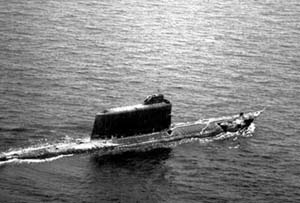Recovery of a fragment of the K-129, a Soviet Golf II class diesel electric missile submarine (SSG) which sank in 1968 by the Hughes Glomar Explorer in 1974. It was a great achievement in ocean engineering, deep water salvage. Michael White film played recently on the Military Channel
"Azorian" (erroneously called "Jennifer" after its Top Secret Security Compartment by the press) was the code name for a U.S. Central Intelligence Agency (CIA) project to recover the sunken Soviet submarine K-129 from the Pacific Ocean floor in the summer of 1974, using the purpose-built ship Hughes Glomar Explorer. The 1968 sinking of the K-129 occurred approximately 1,560 nautical miles (2,890 km) northwest of Hawaii. Project Azorian was one of the most complex, expensive, and secretive intelligence operations of the Cold War at a cost of about $800 million ($3.8 billion in 2013 dollars).
 |
| Golf II SSG on the Surface |
x
Micheal White - AZORIAN - The Raising Of The K-129
Project Azorian: The CIA and the Raising of the K-129: Norman Polmar, Michael White: 9781591146681: Amazon.com: Books
Project Azorian: The CIA's Declassified History of the Glomar Explorer
Current incarnation and location
1 comment:
The Glomar Explorer story is a great story. Too bad another use for the technology could not be found. Some of us at HAC may have actually worked on some of the technology for the Glomar Explorer without knowing it!
But, a good story associated with this mission, that I recall, was an interview carried on one of our local Los Angeles TV stations a couple of years after the mission was complete. In order to staff the ship, experienced shipmen were needed and military people were not allowed on the ship. The best place to recruit experienced sailors was at mustering out sites for naval servicemen in places like Long Beach and San Diego. So a couple of these guys who served aboard the Glomar Explorer were interviewed and asked how they were recruited and what they could tell about their time at sea. “Very Boring” was the major comment, describing life aboard the craft which sat motionless for over three weeks 1500 miles Northwest of Hawaii. When asked if anyone was watching, they said the surrounding waters were filled with Soviet trawlers. When asked how close the trawlers came, they said they could make out the Soviet sailor’s faces. When asked, “Well, what did you do?” They answered, “Well, we gave them the finger!” When asked, “Well, what did the Russian guys do?” “Well, they gave us the finger back!”
I was amused to realize that part of the Cold War battle was being fought by young sailors using their middle fingers in the middle of the Pacific Ocean.
Post a Comment